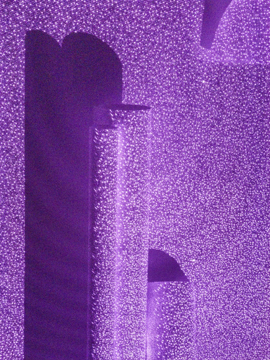Kinect gets artistic
While we’ve always thought that Kinect for Windows was a work of art, figuratively speaking, we are delighted to see the art world embracing the Kinect sensor as a creative tool. Two highly imaginative artistic uses of Kinect for Windows recently caught our attention, and we want to share them with you.
The first is a series of photographs by Israeli artist Assaf Evron, displayed at the Andrea Meislin Gallery in New York City from March 7 to April 25, 2015. Titled Visual Pyramid after Alberti, Evron’s striking photos show the interplay of light on everyday objects. The light is actually from the infrared spectrum emitted by the Kinect sensor. Using a separate infrared camera, Evron captures the Kinect-emitted infrared light as it’s reflected off the objects he’s photographing. The resulting images are a bold purple with a dense overlay of points of reflected infrared light.
 |
This photograph, which captures reflected infrared light emitted by a Kinect sensor,is part of artist’s Assaf Evron’s Visual Pyramid after Alberti, 2013–2014.(Copyright Assaf Evron. Photograph courtesy Andrea Meislin Gallery, New York.) |
The photographs were inspired by the aesthetic philosophy of Renaissance thinker Leon Batista Alberti, who described a theory of linear perspective in his 1436 treatise Della pittura (On Painting) . Alberti provided the mathematical underpinnings of perspective, showing how to render a three-dimensional illusion on a two-dimensional canvas. Evron’s photographs demonstrate Alberti’s theory in dramatic fashion.
Once you’ve stopped pondering Alberti’s ideas, we have a new brainteaser for you: what do you get when you mix performance art, experimental filmmaking, and an avant-garde music composition? Well, throw in two Kinect v2 sensors, some computers, and the right software, and you get as-phyx-i-a, an otherworldly movie that, in the words of creators, “…is centered in an eloquent choreography that stresses the desire to be expressive without bounds.”
The work of co-directors Maria Takeuchi and Frederico Phillips, the three-minute film renders the sinuous dancing of performance artist Shiho Tanaka as a glowing array of light points and spidery connections, all set to a haunting electronic score. The visuals and music are both eerie and beautiful, as the dancer’s image, which seems both digital and human simultaneously, moves gracefully across the screen.
Phillips was responsible for the visuals, which captured some 30 minutes of Tanaka’s dancing as a mesh of point-cloud data using two Kinect v2 sensors. The data from both sensors was combined and then styled with various 3D tools to create the ethereal images on the final film. Composer Takeuchi used a variety of digital and analogue techniques to create the original sound track that accompanies the visuals.
As Visual Pyramid after Alberti and as-phyx-i-a show, Kinect for Windows can be a potent artistic tool in the right creative hands.
The Kinect for Windows Team
Key links